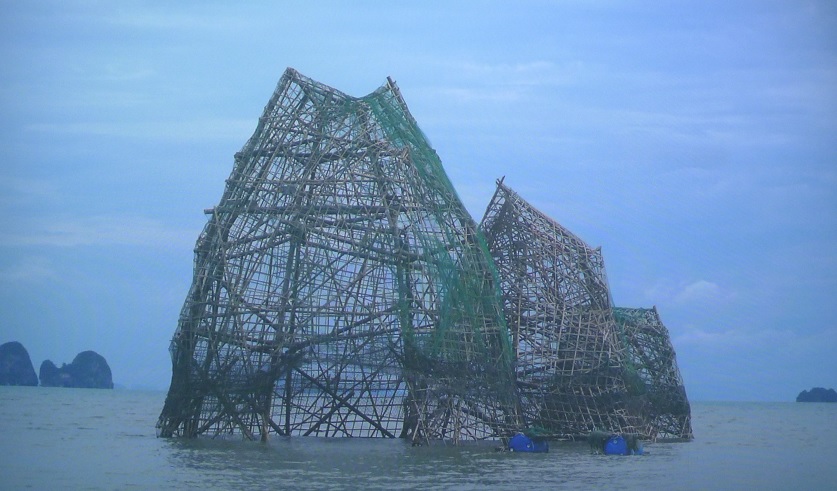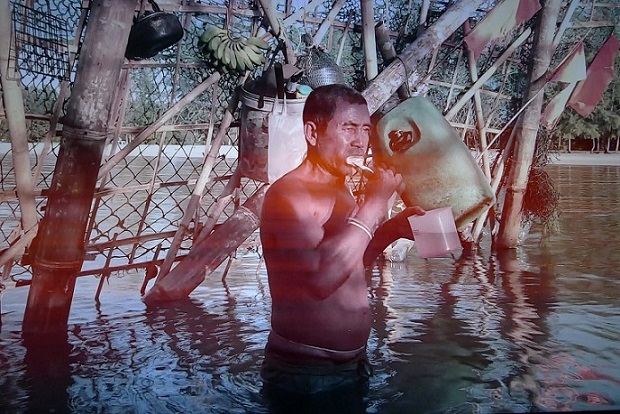Reviews & Articles
我們是那0.01% -責無旁貸 | We are the 0.01% - and responsible
John BATTEN
at 2:31pm on 24th April 2019


圖片說明:
1. Map Office,《安達曼海的鬼島嶼裝置》
2. Map Office,《在海水潮漲時在刷牙的漁夫》
3. 鄭波,《你們是那0.01%》,在地裝置
4. 梁志和,《在這表面爬行》,裝置現場
Captions:
1. Map Office, Ghost Island installation in the Andaman Sea
2. Map Office, Fisherman brushing teeth in rising seawater
3. Zheng Bo, You Are The 0.01%, in-situ installation on grass lawn
4. Leung Chi Wo, Scratching on the Surface, gallery installation
(Please scroll down for English version)
我第一次看到配合大自然而能啟發我的藝術作品,本身就是大自然的一部份。它位於澳洲悉尼以北25公里的庫嶺蓋國家公園水穴旁邊,露出地面沙岩上的土著石刻。這些石刻已有數千年歷史,簡單地勾勒出四週的大自然環境,描繪了魚、鳥、回力鏢,還有人類的足部。這些圖像的簡單表達,較後來出現的繪畫與雕刻技巧早了數千年。人類的存在,以與大自然之間的平衡尤其令人驚嘆。
1960至70年代的大地藝術運動,主要是對商業藝術與市場的回應。大藝術的作品特意設於戶外,並使用戶外空間,通常都在遍遠或臨水之處。早期的藝術家先鋒計有Robert Smithson、Richard Long、Andy Goldsworthy、James Turrell和Ana Mendiata。早年支持這項運動的亞洲藝術家,則有來自菲律賓的David Medalla和Roberto Villanueva。隨著大眾對全球暖化及環境問題的關注已不再限於科學界,特別是在過去10年,大地藝術由擁有戶外藝術的美學演變成有關環境、強而有力的論述。「環境藝術」通常採取的藝術方針均與實地裝置相關,但箇中訊息才是重中之重:對於我們身處世界每況愈下的環境,強烈地表達與提出社會及政治意識。
位於北角的油街實現原本座落於維多利亞港前岸,是《失去了又回來》展覽的最佳展出場地。是次展覽帶來了三個發人深省、與環境相關的裝置,創作者包括香港藝術家梁志和、鄭波,以及MAP Office(由古儒郎和林海華組成的二人藝術家組合)。
展覽的政治背境由鄭波的文字裝置設定,他以深綠色的草在油街實現較淺綠色的草坪上種出了以下字句:「 YOU ARE THE 0.01%」(你們就是那0.01%)。
2011年,經濟學家約瑟夫.史迪格里茲在發表的文章中指出1% 的富有美國人控制了全美40%的財富。同年稍後時間,佔領華爾街運動採用了以這個概念為本的口號「我們就是那99%的人」。鄭氏解釋指:「2018年6月………一項研究指出,人類只佔地球總生物物質的0.01%,但是卻在使用30%生態圈的總初級生產量。我們雖然屬於99%的人,但其實只是生物圈的0.01%。我們要對抗人類的種種不公和生物圈的種種不公。我的(文本)作品中,植物會告訴我們,你們只是那0.01%。」
是我們容許世界環境繼續惡化,所有人都應該對後果負上責任––未來的人們與社群將需在自行尋找的生存方法。
MAP Office展示了兩套意味深長的錄像,還有一個名為《鬼島嶼》的裝置。他們的錄像《鬼島嶼的誕生》紀錄了三個人工島的築成經過,人工島位於泰國安達曼海喀比附近的潮灘,由兩位藝術家設計。經驗豐富的承建工人擁有熟練的用竹技能,由零開始建造出人工島:把破開的竹子綁起,加上在鄰近海面找來的棄置漁網,讓人工島更加堅固,慢慢成形。這些新建的竹島,形狀有如鄰近的美麗水蝕石炭岩群島。油街實現展場內重建了類似的竹島,部份由長洲漁民和香港清潔海灘義工建成。
第二段錄像紀錄了在安達曼海鬼島嶼上生活漁夫的虛構日常。一大清早,我們看著這位瘦削結實的漁夫睡醒,海水湧至他的吊床旁。他的早上活動包括準備鮮魚,再以不太安穩地在浮台上平衡著的炭爐上烹調;接下來是刷牙、梳洗,所有活動都在深及腰部的海水中進行。時間隨著退潮過去,海沙成了地面,浮台成了工作空間:漁夫修補漁網並製作捕魚器。忙過一天後,他在吊床上邊抽著煙邊休息。到了晚上,人工島以太陽能燈作照明。最後,漁夫再次在汐漲之間睡去,海水再次湧向他的吊床。這些錄像靈巧地表達了一個環境問題:海面因為全球暖化而上升,最後會淹沒脆弱的島嶼。
梁志和的裝置採用了另一種方向。展館中放置了一池靜止的真正海水,其後兩條頻道的錄像投影出流水正在改變的地貌,刻劃原始的大自然。錄像在海水的鏡面上反射。每隔一段時間,一枝像是掃的桿子掉落到水的表面,突然間打破了水的靜止和我們的集中力。梁氏的裝置表面上是一系列觀察與關於記憶的層次。或者,更準確說,代表了我們脆弱、頃刻的記憶,以水對記憶的流動作出迴響。藝術家以鏡頭紀錄了自然世界的美麗影像,但是連他也對自己採用的工具存疑:「我喜歡攝影,但它卻干擾我的記憶……」
如果你從鄰近的北角和九龍城碼頭乘坐渡海小輪到達,這個精緻的展覽將會更加震撼,特別是對於小朋友來說。香港令人刮目相看的發展,顯然令脆弱的天然環境不堪重負。
展覽詳情:
失去了又回來
22/3/2019 – 28/7/2019
香港北角油街12號油街實現
原文刊於《明報周刊》,2019年4月13日
We are the 0.01% - and responsible
by John Batten
The first inspiring art I saw that complemented nature – indeed, was part of nature – were the Aboriginal rock carvings in the sandstone outcrops beside water holes in the beautiful Ku-ring-gai Chase National Park, twenty-five kilometres north of Sydney, Australia. Dating back thousands of years, these rock engravings were simple, outlined depictions of the surrounding nature, including fish, birds, boomerangs, the human foot. The simplicity of these images predated later drawing and engraving techniques by thousands of years. Humanity’s presence and balance within the natural environment was especially awe-inspiring.
The Land Art movement of the 1960s and 1970s was predominantly a reaction against commercial art and the marketplace. Land Art was artwork intentionally situated within and using an outdoor space, often in remote rural or water locations. Early artist pioneers include Robert Smithson, Richard Long, Andy Goldsworthy, James Turrell and Ana Mendiata; early proponents in Asia were the Philippine artists David Medalla and Roberto Villanueva. As community concern about global warming and environmental issues moved outside scientific circles, especially during this last decade, Land Art evolved from having an outdoor art aesthetic to be a strong commentary about the environment. ‘Environment Art’ often uses the artistic approaches related to site-specific installation, but the message is always central: to strongly express and raise social and political consciousness about our world’s degraded environment.
Originally located on Victoria Harbour’s foreshore, Oi! in North Point, is perfect for the exhibition Once lost but now found, featuring three thoughtful installations about the environment by Hong Kong artists Leung Chi Wo, Zheng Bo and MAP Office (the artist duo of Valérie Portefaix and Laurent Gutierrez).
Setting the exhibition’s political context is Zheng Bo’s text installation using dark green grass growing on Oi!’s lighter-coloured lawn; his text bluntly states: YOU ARE THE 0.01%.
In 2011, economist Joseph Stiglitz identified that 1% of wealthy Americans controlled 40% of USA wealth. Later that year, Occupy Wall Street adopted as a slogan: “We are the 99%” - Zheng further explains: “In June 2018…a study estimated that humans account for only 0.01% of the total biomass on earth, but consume about 30% of the biosphere’s total primary production. While many of us are the 99%, we are also actually the 0.01% of the biosphere. We need to fight against inequality AND against biosphere inequality. In (my text artwork), the plants tell us that we are only the 0.01%.”
As we allow the world’s environment to further degrade, we are all responsible for the consequences - and individuals, and communities, in the future will need to manage their own survival.
MAP Office show two eloquent videos and an installation entitled Ghost Island. Their video, The Birth of Ghost Island, records the construction of three artificial islands designed by the artists on a tidal beach near Krabi on Thailand’s Andaman Sea. The experienced contracted workmen are adept with bamboo and build the artificial islands from scratch: strips of tied split bamboo and fishing nets found abandoned in the surrounding sea give strength, shape and form; and these new bamboo islands mirror the shape of the beautiful surrounding karst islands. Reconstructed in Oi! is a similar bamboo island, partially built by Cheung Chau Island fisherman and Hong Kong beach-cleaning volunteers.
A second video records a fictional day for a fisherman living on the Andaman Sea’s Ghost Island. In early morning, we watch this wiry fisherman wake as water laps beside his hammock. His morning activities of preparing and cooking fish on a charcoal stove (precariously balanced on a floating platform), brushing teeth, and washing himself, are all done in waist-deep sea water. As the day progresses, the tide retreats, sand becomes a floor and the platform becomes a work space: the fisherman repairs nets and makes fish traps. At the end of the day, he rests in his hammock, smoking. At night, the islands are lit by solar-powered lamps. Finally, the fisherman sleeps as the tide, again, rises - and, again, water laps against his hammock. These videos skillfully present one of many environmental issues, including that seawater levels due to global warming will drown vulnerable islands.
Leung Chi Wo’s installation takes a different approach. Depicting pristine nature, a two-channel video projection of a changing landscape of flowing water sits behind a quiet pool of actual seawater installed in the gallery. The videos are reflected on the pool’s mirror water surface. Intermittently, a tree brush falls onto the surface of the water and suddenly breaks the water’s stillness and our concentration. Leung’s installation is ostensibly a series of observations and layers about memory. Or, to be more precise, our fragile, momentary grasp of our memories, with “water echoing the fluidity of memory”. The artist uses a camera to record images of the beautiful natural world, but even he is skeptical about the tool he uses: “I like photography, but it interferes with my memory….”
This fine exhibition could have more impact, especially for children, if you arrive by catching a cross-harbour ferry between the nearby North Point ferry and Kowloon City ferry terminals. Then, Hong Kong’s impressive development can clearly be seen to have overwhelmed the fragile natural environment.
Exhibition details:
Once lost but now found
22/3/2019 – 28/7/2019
Oi!, 12 Oil Street, North Point, Hong Kong
This article was originally published in Ming Pao Weekly, 13 April 2019. Translated by Aulina Chan.
